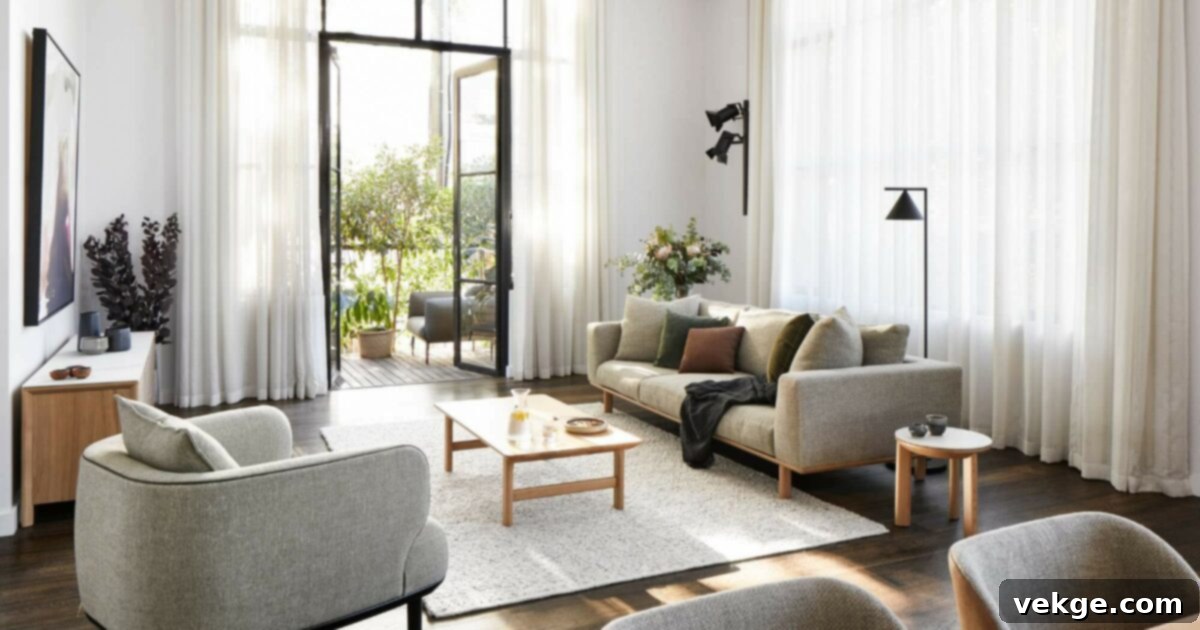Create Your Sanctuary: The Ultimate Guide to an Organic Modern Living Room
Welcome to the world of the organic modern living room, a design philosophy that beautifully bridges the raw, serene beauty of the outdoors with the clean, elegant lines of contemporary design. More than just a trend, this style offers a sanctuary—a personal haven that resonates with the tranquility of nature and the allure of minimalistic, sophisticated aesthetics. It’s about crafting a living space that not only looks stunning but also promotes well-being and a deeper connection to the natural world.
In this comprehensive guide, we will embark on a journey to explore the essential elements of organic modern design. We’ll delve into the power of neutral palettes, the charm of eco-friendly accessories, and the profound impact of integrating natural elements. Discover how to effortlessly infuse your indoor spaces with lush plants, select mindful furnishings, and create an inviting atmosphere that radiates both undeniable style and ultimate comfort. Prepare to refine your living area into a harmonious blend of contrasting worlds, celebrating both the wild and the refined.
What is Organic Modern Living Room Design?
At its core, an organic modern living room is a thoughtfully curated space where the warmth and texture of nature seamlessly merge with the sleek simplicity of modern minimalism. It’s a design approach that goes beyond aesthetics, emphasizing comfort, functionality, and a strong, tangible connection to the environment. The essence of this style is built upon several key principles:
- Connection to Nature (Biophilia): Organic modern design actively seeks to bring the outside in. This includes incorporating indoor plants, maximizing natural light, and using materials that evoke the natural world.
- Minimalism and Functionality: It embraces the “less is more” philosophy, focusing on essential, well-designed pieces that serve a purpose rather than excessive ornamentation. Furniture is often chosen for its clean lines and practical utility.
- Neutral and Earthy Palettes: The color scheme typically revolves around soothing, natural tones like whites, creams, beiges, grays, and subtle earthy browns and greens, creating a calm and expansive feel.
- Sustainable and Natural Materials: There’s a strong preference for sustainable materials such as wood, stone, rattan, jute, wool, and organic cotton, which not only add texture and warmth but also contribute to a healthier home environment.
- Comfort and Well-being: While modern in its lines, comfort is paramount. Plush seating, soft textiles, and a generally inviting atmosphere are crucial to fostering relaxation and promoting overall well-being.
This design philosophy fosters a profound sense of tranquility and peace, significantly contributing to the mental and physical well-being of its inhabitants. The thoughtful blend of contemporary living with sustainable practices creates a visually appealing and uniquely aesthetic living area. Beyond beauty, natural elements like indoor plants and ample sunlight are known to improve indoor air quality, reduce stress levels, and enhance a healthier living environment. The warm and soothing ambiance can also boost creativity and productivity, making it an ideal space for both relaxation and focused work. Furthermore, an organic modern home subtly imparts educational value, teaching children about sustainability and fostering awareness about responsible living choices.
Crafting Your Organic Modern Living Room: A Step-by-Step Guide
Creating an organic modern living room is an exciting journey of balancing aesthetics, comfort, and sustainability. Here’s how you can transform your space:
1. Envision and Design the Concept

Before selecting a single piece of furniture, take time to envision your ideal organic modern living room. Think about the overall mood and atmosphere you wish to create. This style prioritizes a relaxed, serene environment, so consider how each element contributes to this feeling.
- Color Palette: A neutral color palette is foundational. These soft tones—creams, off-whites, warm beiges, gentle grays, and muted greens—reflect light beautifully, making spaces feel larger and more open. If your room receives an abundance of natural light, you can venture into slightly richer, yet still natural, tones. For darker rooms, lighter shades are crucial to brighten and expand the space.
- Open and Airy Layout: Aim for an uncluttered and spacious feel. Minimize furniture to only essential pieces, ensuring there is ample space for movement and visual breathing room. This open layout enhances the flow of energy and promotes a sense of calm. Each piece of furniture and decor should reflect simplicity, natural warmth, and unpretentious elegance.
- Maximizing Natural Light: Evaluate how natural light enters your room. Can you enhance it with sheer curtains, strategically placed mirrors, or by keeping window treatments minimal? Natural light is a cornerstone of organic modern design, illuminating the natural textures and colors within the space.
2. Embrace Natural Materials and Textures
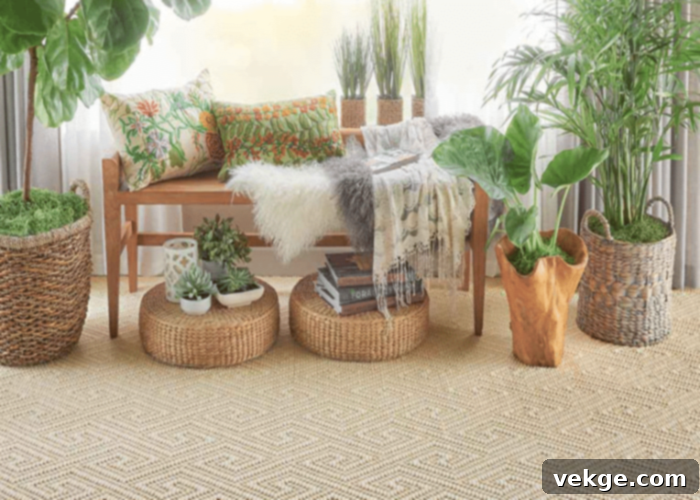
This is where the “organic” aspect truly shines. Incorporating elements directly from nature creates a rich, sensory experience and a deep connection with the outdoors.
- Wood: Opt for furniture made from reclaimed, sustainably sourced, or solid wood with visible grain. Light woods like maple, ash, or birch, or richer tones like walnut, can provide warmth and grounding. Consider wooden coffee tables, side tables, or shelving.
- Stone: Introduce elements of stone through accent pieces, a fireplace surround, or even decorative bowls. Marble, travertine, and river stones add a touch of raw elegance and varied textures.
- Organic Fabrics: Prioritize textiles made from natural fibers. Jute, sisal, or wool rugs add texture and softness underfoot. Cushions and throws made from organic cotton, linen, or hemp provide comfort and a tactile appeal. These materials are not only sustainable but also breathe well and age beautifully.
- Biophilic Elements (Plants): Infuse greenery generously. Large indoor plants in beautiful pots (think terracotta, ceramic, or marble) can become focal points, while smaller plants like succulents or snake plants purify the air and add subtle life to shelves and tables. Plants like Fiddle Leaf Figs, Monstera, or Bird of Paradise contribute significantly to the biophilic magic.
- Artwork and Decor: Select pieces inspired by nature. Botanical prints, abstract landscapes in earthy tones, or simple, elegant sculptures made from wood or stone will enhance the natural aesthetic without overwhelming the space. The goal is to balance modern aesthetics with the inherent warmth of natural elements, all while optimizing natural light to showcase these beautiful textures.
3. Select Minimalist Furniture with Purpose
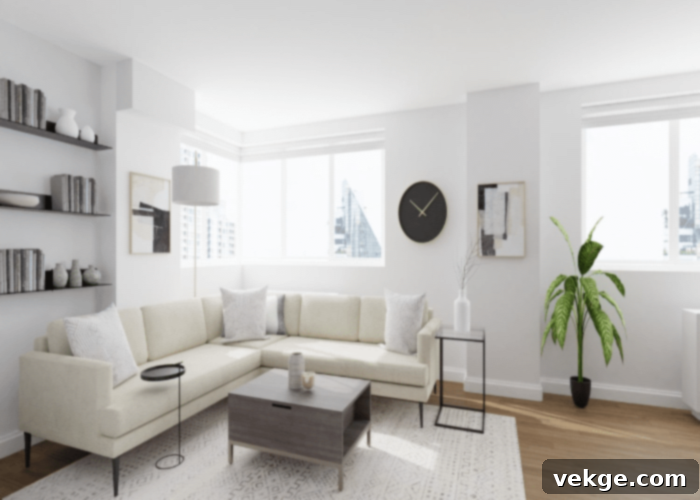
When selecting furniture for an organic modern living room, the focus shifts from ornate decoration to clean lines, simple forms, and supreme functionality. Each piece should be chosen deliberately, contributing to the overall sense of calm and order.
- Form and Function: Prioritize furniture that offers both aesthetic appeal and practical utility. Look for pieces with clean silhouettes, smooth finishes, and a timeless design that will endure beyond fleeting trends.
- Cohesive Design: Ensure that your furniture choices harmonize with the overarching theme and color palette of the room. Pieces should complement each other, creating a sense of unity and flow.
- Multifunctional Pieces: Embrace smart design with multifunctional furniture. A coffee table with hidden storage, a modular sofa that can be reconfigured, or an ottoman that doubles as extra seating are excellent choices for maintaining an uncluttered look while maximizing utility.
- Quality Over Quantity: Invest in high-quality furniture. Well-crafted pieces, often made from natural materials, not only last longer but also develop a beautiful patina over time, telling a story of their own. This commitment to longevity aligns perfectly with sustainable living.
- Mindful Sizing: Be highly aware of the room’s dimensions. Furniture should fit comfortably without overcrowding the space, ensuring a balanced and airy look. Aim for mixed seating options like a comfortable sofa, a couple of elegant armchairs, and perhaps an ottoman or floor cushions to add versatility and visual interest.
- Material Harmony: Finally, ensure that the colors, textures, and materials of your furniture selections thoughtfully complement the broader aesthetics of your organic modern living room. For example, a linen-upholstered sofa pairs beautifully with a solid oak coffee table.
4. Thoughtful Decor and Styling
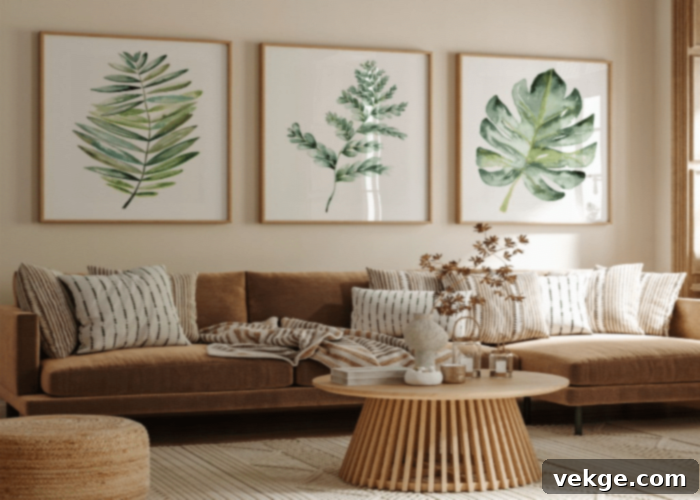
Choosing decor for an organic modern living room involves a delicate balance of natural textures and contemporary aesthetics. Every item should serve a purpose or bring joy, avoiding unnecessary clutter.
- Sustainable and Handcrafted Accessories: Opt for decor made from recycled, upcycled, or sustainably sourced materials. Think wooden bowls, stone sculptures, hand-thrown ceramic vases, woven baskets, and bamboo accents. These pieces add character and a sense of artisanal quality.
- Greenery as Decor: Beyond large plants, use smaller, easy-to-maintain indoor plants like succulents, air plants, or Pothos in minimalist planters to infuse pockets of green throughout the space. Terrariums or small herb gardens can also add a unique touch.
- Lighting as Art: Select lighting fixtures that blend natural elements with modern design. Pendants with woven shades (rattan, bamboo) or fixtures with ceramic or matte metal finishes can provide ambient light while acting as sculptural elements. Soft, warm lighting is key to creating a cozy and inviting atmosphere. Consider dimmers for versatility.
- Curated Artwork: Choose artwork that complements the natural theme. This could include abstract pieces in earthy tones, photographs of serene landscapes, or botanical illustrations. The artwork should add visual interest without being overly dominant, maintaining the calm aesthetic.
- Textile Layers: Even with a minimalist approach, layering textiles adds warmth and depth. Incorporate soft throws made of organic cotton or wool, and accent pillows with subtle textures (think slub linen or a subtle boucle) to enhance comfort and visual appeal.
5. Prioritize Comfortable Seating
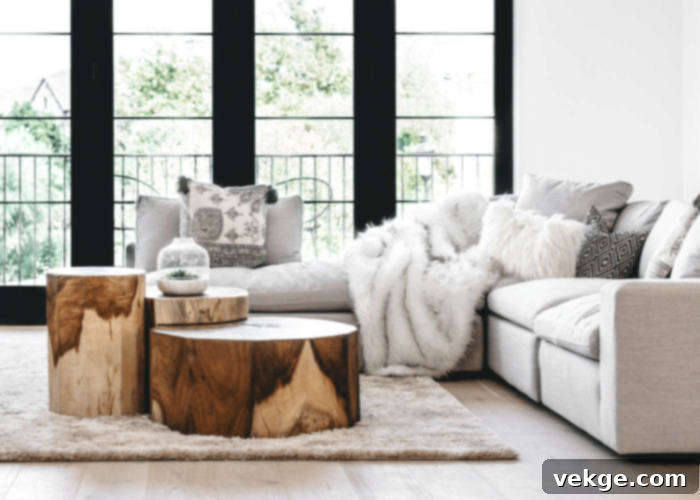
In any living room, comfort is paramount, and in an organic modern space, seating should explicitly encourage relaxation, intimate conversations, and quality time spent with loved ones. It’s about creating an inviting embrace.
- Natural Upholstery: Opt for seating upholstered in natural, breathable materials like organic cotton, linen, jute, or wool. These fabrics offer a pleasant tactile experience and contribute to the room’s earthy aesthetic. For a touch of luxury and deep texture, consider fabrics like bouclé or chenille, which can add warmth and visual interest while still feeling organic.
- Plush and Inviting: While maintaining minimalist lines, ensure that cushions are plush, well-padded, and incredibly inviting. The seating should feel soft and supportive, encouraging lingering and comfort.
- Ergonomic Considerations: Pay close attention to ergonomic details. Lumbar support, comfortable armrests, and appropriate seat depth are crucial for long-term comfort. A well-designed sofa or armchair should support your body, allowing you to truly relax.
- Versatile Seating Arrangements: Mix and match seating options to create a dynamic yet comfortable layout. A large, inviting sofa can be complemented by a couple of armchairs, perhaps a stylish ottoman that doubles as a footrest or extra seating, and even floor cushions for a more casual, relaxed vibe.
- Layering for Coziness: Enhance the comfort quotient with soft throws draped over seating and a selection of accent pillows. These elements not only add a touch of personalization and color (if desired) but also increase the visual and tactile comfort of the space. Consider pillows with varying textures and subtle patterns that echo the natural theme.
- Durability and Longevity: Choose seating that is built to last. High-quality construction ensures that your comfortable pieces will remain a cherished part of your living room for years to come, aligning with the sustainable ethos of organic modern design.
Conclusion: A Lifestyle, Not Just a Design
As we’ve explored, an organic modern living room is far more than a passing trend; it is a thoughtful lifestyle choice. It embodies a harmonious fusion of nature’s calming embrace and contemporary style, representing an example of sophisticated living blended with the raw, untouched beauty of the natural world. From consciously chosen sustainable accessories to sumptuously cozy fabrics, from the vibrant life of indoor plants to the grounding presence of earthy-toned abstract art, every decision you make in this design journey contributes to a compelling narrative of balance, comfort, and environmental mindfulness.
Imagine yourself sinking into a generously padded armchair, bathed in the soft glow of ambient lighting, surrounded by beautifully handcrafted ceramics and the subtle scent of greenery. Let the profound tranquility wash over you. Your organic modern living room is not merely a collection of furniture and decor; it is a living, breathing testament to elegance, the richness of nature, and a mindful approach to home design that nurtures both the spirit and the environment. It is your personal sanctuary, reflecting a timeless appreciation for natural beauty and modern serenity.
